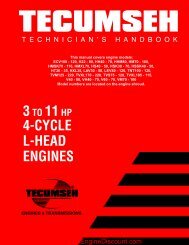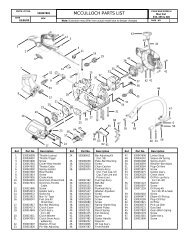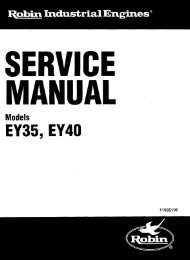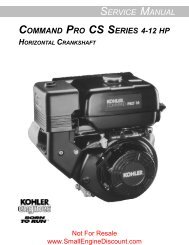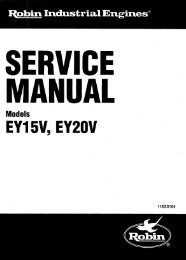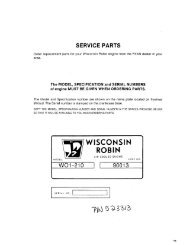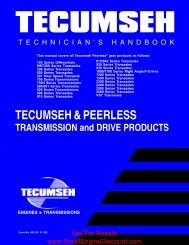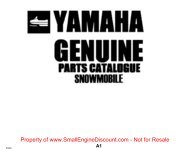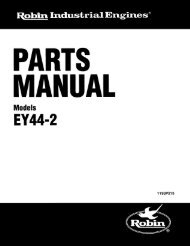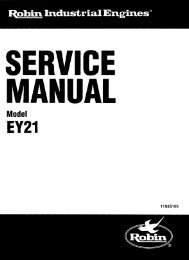4-CYCLE OVERHEAD VALVE ENGINES - Small Engine Discount
4-CYCLE OVERHEAD VALVE ENGINES - Small Engine Discount
4-CYCLE OVERHEAD VALVE ENGINES - Small Engine Discount
Create successful ePaper yourself
Turn your PDF publications into a flip-book with our unique Google optimized e-Paper software.
CONVERTING ALTERNATING CURRENT<br />
TO DIRECT CURRENT<br />
ANODE<br />
CATHODE<br />
In order to charge a battery, it is necessary to convert<br />
alternating current (A.C.) to direct current (D.C.). This<br />
is accomplished by using a diode or rectifier (diag.<br />
3). A single diode makes use of only one half of the<br />
A.C. signal and is known as HALF WAVE<br />
RECTIFICATION (diag. 4). This is acceptable in<br />
certain applications. In certain situations it is<br />
necessary to make use of the entire A.C. signal. To<br />
accomplish this, multiple diodes in a bridge<br />
configuration are used to produce FULL WAVE<br />
RECTIFICATION (diag. 5).<br />
BAND OR OTHER<br />
MARKING INDICATES<br />
CATHODE END<br />
3<br />
Current flows through a diode when the anode is more positive than the cathode. The cathode end of the diode<br />
should point toward the battery when diode is used between a charging system and a battery.<br />
Half Wave Rectifier Single Diode<br />
The single diode allows only the positive half of the A.C. signal through. It does not allow the negative portion<br />
through.<br />
+ VOLTAGE<br />
HALF WAVE RECTIFIER<br />
(SINGLE DIODE)<br />
+ VOLTAGE<br />
- VOLTAGE<br />
A.C. INPUT<br />
- VOLTAGE<br />
D.C. OUTPUT<br />
4<br />
Full Wave Rectifier Bridge Rectifier<br />
The full wave rectifier makes use of the entire A.C.<br />
signal, converting it to D.C.<br />
+ VOLTAGE<br />
FULL WAVE RECTIFIER<br />
(BRIDGE RECTIFIER)<br />
COMPONENTS<br />
- VOLTAGE<br />
A.C. INPUT<br />
BATTERY<br />
The batteries used in conjunction with Tecumseh<br />
engines are 12 volt lead acid or “maintenance free”<br />
style. The chemical energy produced by the dissimilar<br />
metals of the battery plates provides a electrical<br />
potential that is used to power the electric starter or<br />
unit accessories. Consult the original equipment<br />
manufacturer’s service manual for battery size,<br />
capacities, and testing procedure.<br />
A.C. INPUT<br />
+ VOLTAGE<br />
- VOLTAGE<br />
D.C. OUTPUT<br />
+ VOLTAGE (D.C.)<br />
5<br />
WIRING<br />
The wires used in Tecumseh electrical systems are copper stranded with an insulated coating around the<br />
copper strands.<br />
CONDITION: All wiring must be fully insulated between connection points, securely fastened and free of<br />
foreign material (such as rust and corrosion) at the connection points. This is especially important in the use of<br />
batteries where much of the potential may be lost due to loose connections or corrosion. Remember to check<br />
the insulation on the wire. All it takes is a pin hole for leakage to "ground out" on the engine or frame. This is of<br />
special concern when moisture or water is present.<br />
36<br />
Not For Resale<br />
www.<strong>Small</strong><strong>Engine</strong><strong>Discount</strong>.com




